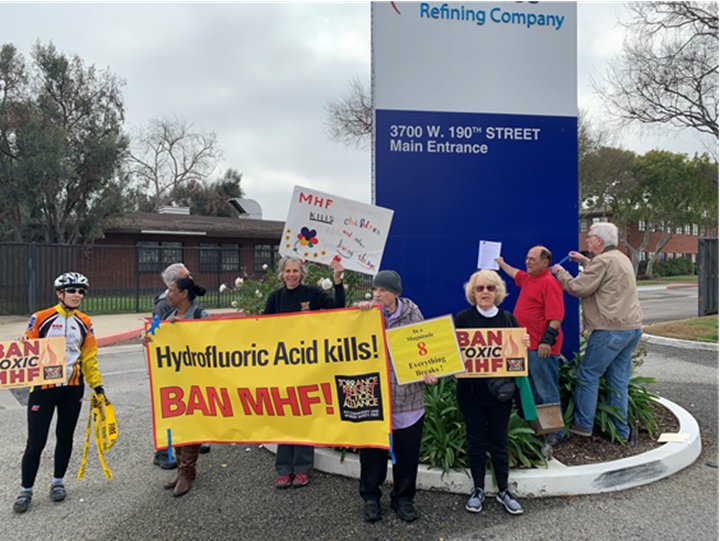The Danger
Among the world’s most dangerous industrial chemicals, hydrogen fluoride (HF) is used in massive quantities in only two of California’s 15 refineries: the Torrance Refining Company (ToRC) and Valero in Wilmington — both located in the densely populated South Bay region of Southern California. In a major accidental release, as shown in an alarming video of the 1987 “Goldfish” test in the Nevada desert, HF can form a ground-hugging aerosol cloud that can drift for miles, causing irreversible injury and death.
Who’s At Risk?
The United States Environmental Protection Agency (EPA) uses Emergency Response Planning Guidelines (ERPGs) to assess worst-case scenarios. Residents inside the black circles below are at risk of serious and irreversible health effects (ERPG-2). Those inside the red circles are at risk of life-threatening health effects (ERPG-3). Those downwind of an HF release are exposed. Many in the highly dangerous regions close to the refineries rank high for Environmental Justice burden.

Commercially Available Alternatives
It doesn’t have to be like this. People don’t have to live in fear of an HF release from their local refinery. A growing number of HF refineries in the nation have successfully converted or are currently converting to modern, proven commercially available alternatives.
The Refineries’ Big Lie
In the wake of the alarming results of the Goldfish tests, Mobil engineers attempted to develop an additive that would reduce the volatility of HF and prevent the formation of an aerosol cloud. The attempt failed, but the failure was hidden from the public. The Torrance Refining Company and Valero continue the false claims about the additive, they say makes HF safe enough to use in the densely populated South Bay. They call the mixture “modified” HF, or MHF.

In fact, Torrance Refining Company and Valero’s Big Lie about this ineffective additive is the primary reason we have HF in the two refineries today. It was at the center of the arguments to the SCAQMD and the courts that allows use of HF. Congressman Ted Lieu was entirely correct when he said the South Bay community had been “hoodwinked” into believing an additive mixed into the acid actually made it any safer, when there was no evidence that was the case. Of the approximately 50 refineries across the nation that still use HF, only ToRC and Valero use the additive. If it had the safety effectiveness claimed, one would think at least some HF refineries in the world outside the South Bay would use it. None do.
For MHF not to interfere with the refining process, the refineries keep the concentration of the additive as low as one molecule for every 100 molecules of HF (1% molar concentration). Like Dumbo’s feather, the additive has no real purpose, except to dupe regulators and the courts to allow the refineries to continue to use HF. Members of TRAA’s Science Advisory Panel thoroughly debunked the refineries’ additive claims in three articles here, here, and here.
For decades, ToRC and Valero have hidden test data on the additive’s lack of effectiveness behind a wall of proprietary secrecy. In the AQMD’s most recent attempt to ban HF, its technical staff became the first and only government entity to view the voluminous data. It concluded [page 4&5], “the testing/modeling information provided by TORC did not sufficiently demonstrate MHF would not flash atomize and form a dense HF cloud.” The AQMD staff also independently confirmed [page 22] TRAA Science Advisory Panel’s own assessment that there was “No testing conducted at current operating conditions.”
ToRC and Valero’s Big Lie was on full public display at the AQMD Refinery Committee Meeting in Wilmington, California on September 22, 2018. Two invited presenters — acknowledged as among the world’s leading experts on the dangers of hydrogen-fluoride use in refineries — were asked The $64,000 Question: “Does MHF behave the same as HF?” Both experts testified that the additive would have a very small effect, and they weren’t aware of any data that supports the refineries’ claims for it.
TRAA Initiatives
Campaign Urging Governor Gavin Newsom To Request an Investigation of the Torrance Refining Company & Wilmington’s Valero Refinery

On February 18, 2020 — the five-year anniversary of the Torrance refinery explosion — TRAA announced a campaign urging Governor Gavin Newsom to request the Attorney General to investigate — based on newly available irrefutable evidence — the lack of basis for two legal processes that allow the Torrance Refining Company and Wilmington’s Valero Refinery to use massive amounts of hydrogen fluoride that imperil the surrounding communities. An investigation is the essential precursor to a lawsuit by the State Attorney General to ban the use of HF in the refineries.
TRAA Voter Advisory Project
| SAVE THE DATE – Torrance Refinery Action Alliance (TRAA)’s 9th Anniversary of a near-release of deadly HF Join us on Saturday, February 17th from 10am until 11:30 am @ Columbia Park, Prairie Ave. (north of 190th St.) in Torrance, CA |
The TRAA Voter Advisory Panel has been newly formed to provide voters with information on candidates whose views most closely align with TRAA’s. Their voter recommendations will be posted on this website’s In The News blog.
TRAA National Campaign
Motivated by TRAA friend and former Managing Director of the U.S. Chemical Safety Board Daniel Horowitz’ New York Times Opinion Piece This Chemical Kills. Why Aren’t Regulators Banning It?, TRAA has stepped onto the national scene in support of President Biden’s Executive Order Protecting Public Health and the Environment and Restoring Science To Tackle the Climate Crisis. In its first foray, TRAA coordinated spoken and written comments on the dangers of HF for EPA’s virtual public listening sessions on an enlightened Risk Management Plan (RMP) rule and submitted a proposed amendment to the RMP Rule that would compel refineries to convert from HF to a vastly safer alternative.
Informing the Public about Vastly Safer HF Alternatives
IONIC-LIQUID ALKYLATION
Chevron’s ISOALKY™ alkylation process was used in the recent conversion of its Salt Lake City refinery and is being used in the current conversion of Big West Oil’s Salt Lake City refinery. And, in February 2022, Tüpraş announced it has selected Chevron’s ISOALKY™ for its four Turkish refineries.
Well Resources’s Ionikylation ionic-liquid alkylation process is used in a dozen refineries in China. The SCAQMD praised Well’s novel alkylation technology in its ability to mitigate “safety concerns related to volatile acid vapor clouds and acid transportation.”

SULFURIC-ACID ALKYLATION
Sulfuric-acid alkylation is used in Chevron’s El Segundo refinery and in over half of the nation’s refineries that have alkylation units.
Elessent’s ConvEx℠ HF alkylation conversion technology (developed by DuPont Clean Technologies) enables refiners to convert from HF alkylation to modern, vastly safer, sulfuric-acid alkylation technology. And, as Elessent’s website states, “This new technology offers refiners the opportunity for significant capacity increases at minimal additional cost.” Find full information in the article:
Hydrofluoric Acid Alkylation Conversion and Expansion
by Shane Presley and Jason Nunez
DuPont Clean Technologies
Lummus Technology’s CDAlky® sulfuric-acid alkylation technology is an advanced sulfuric acid alkylation process that operates at significantly lower temperatures than conventional technology—below 0°C—which favors the formation of the desired product.–
SOLID-ACID ALKYLATION
KBR’s Solid Acid Alkylation Technology K-SAATTM is being used by CVR Energy in the conversion of its HF refinery in Wynnewood, Oklahoma.
Lummus Technology’s AlkyClean® gasoline alkylation technology employs a zeolite catalyst formulation. Lummus states that the total installed cost of the facility is lower than current liquid-acid processes, as the lack of corrosive acids in the system and the mild operating conditions allow for carbon-steel construction.
For SCAQMD’s update on alternatives to HF alkylation, see the section Alternative and Emerging Alkylation Technologies (report pages 16-21, pdf pages 18-23) in the March 2022 SCAQMD report: Status Update to the South Coast AQMD Refinery Committee on Implementation of Hydrogen Fluoride Safety Enhancements in Proffer Letters for Torrance Refining Company and Valero Refinery.
